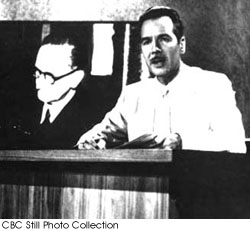
Year Born: 1917
Year Died: 2006
Pioneer
Henderson, Larry (1917-2006)
Larry Henderson marked a transition in news at CBC-TV. The service was less than two years old in 1954 with five-minute news bulletins assigned to a variety of announcers who would not distract the viewer from the words. But CBC managers agreed that the news was disjointed and its presentation uninteresting.
Mavor Moore was program director and he picked Larry Henderson to represent the face of CBC-TV news. Larry was thought to be strong enough to provide continuity, but not individualistic enough to distract viewers. By the end of 1954, Mavor Moore had also increased Larry’s shows to 15 minutes, twice a day, with film and still pictures providing a stronger visual impact than CBC-TV news had previously had. And despite CBC management’s distrust of the star system, Larry was being recognised in the street. He also gained a reputation as the bad boy of television and was known to swear on air, accelerate his reading until it was unintelligible when signalled to speed it up, and once even walked off the set when a film didn’t roll when he signalled for it.
Larry was born in Montreal and attended McGill University for three years on a music scholarship, but in 1936 he sailed to England with $50 in his pocket. He wanted to be a Shakespearean actor. For three he years worked in an assembly line and on and behind the stage. In 1940 he returned to Canada and joined the Toronto announcing staff of the CBC, at the same time studying electrical engineering. He trained in the reserves and transferred to active duty in 1943, serving in North Africa and Italy as a signal corps lieutenant. Out of the army, he became a CBC radio announcer in 1946 and in 1948 took over the show Headliners on CFRB Toronto. In 1949, with a new sponsor, Headliners was heard in Ontario and Quebec on 24 private radio stations.
In 1949, Larry married Joan Annand, whom he’d met at the CBC, and they had two sons. In 1950, he and Joan carried a recorder to Europe and recorded shows for Headliners, retracing the steps of the Canadian army through Italy. When the Korean war began in June, 1950, Larry became the first Canadian broadcaster to cover the war, spending six weeks in Korea. He followed that up with a Far East tour, in turn followed by three years of travel through Europe recording shows for Headliners and a CBC show Passport to Adventure. In 1953 he attended a special seminar on European Unity at the School of International Studies in Geneva.
In 1954 he accepted the CBC-TV newsreader position, supplementing his income with lectures on international affairs to clubs and conventions. He wanted CBC-TV to start an in-depth news program, to become the Edward R. Murrow of the CBC, as Maclean’s Magazine put it in 1958. It was not the CBC’s policy to have personality reporters, however.
Larry was the face of CBC-TV news for six years. Newsreaders read from paper in the 1950s but his trademark was to memorize the script so it appeared he was talking to the audience from personal knowledge. In 1959 he was succeeded by the unruffled, unflappable Earl Cameron and went to work for CHFI Toronto, CHCH-TV Hamilton and, in 1964, to join CTV News as an international affairs expert and weekend news host. He left in the late 60s to lecture and write – he was the author of several books on international affairs – and to run the Larry Henderson School of Television in Toronto. When he sold the school, it was the end of his involvement in broadcasting in Canada, but not in broadcasting generally – for in 1970, he went on assignment for the Canadian International Development Agency to Dar es Salaam, Tanzania. His job there was to help reorganize programming for the east African country’s national broadcasting corporation.
Larry Henderson died on November 26th 2006.
Written by Jerry Fairbridge – November, 2002
